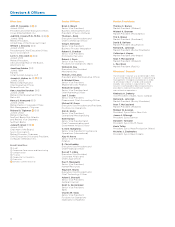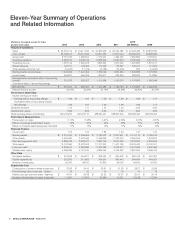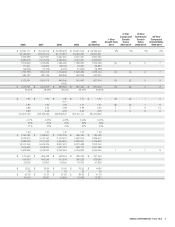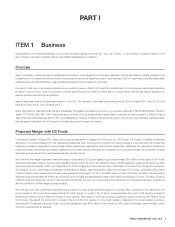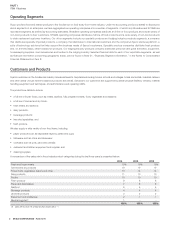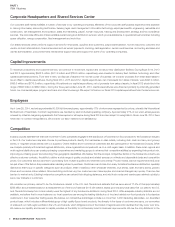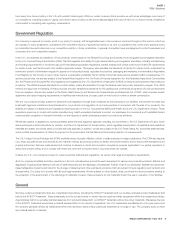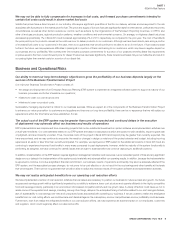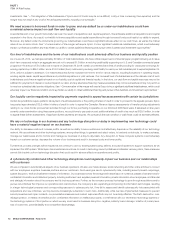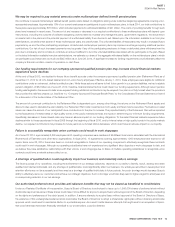Sysco 2014 Annual Report Download - page 16
Download and view the complete annual report
Please find page 16 of the 2014 Sysco annual report below. You can navigate through the pages in the report by either clicking on the pages listed below, or by using the keyword search tool below to find specific information within the annual report.
SYSCO CORPORATION-Form10-K4
PARTI
ITEM1Business
Corporate Headquarters and Shared Services Center
Our corporate staff makes available a number of services to our operating companies. Members of the corporate staff possess experience and expertise
in, among other areas, accounting and nance, treasury, legal, cash management, information technology, employee bene ts, engineering, real estate and
construction, risk management and insurance, sales and marketing, payroll, human resources, training and development, strategy, and tax compliance
services. The corporate of ce also makes available warehousing and distribution services, which provide assistance in operational best practices including
space utilization, energy conservation, eet management and work ow.
Our shared services center performs support services for employees, suppliers and customers, payroll administration, human resources, customer and
vendor contract administration, nancial services such as vendor payments, invoicing, cash application, certain credit services, accounting and sales and
use tax administration, procurement and maintenance support and sales support for some of our operating companies.
Capital Improvements
To maximize productivity and customer service, we continue to modernize, expand and construct new distribution facilities. During scal 2014, 2013
and 2012, approximately $523.2 million, $511.9 million and $784.5 million, respectively, were invested in delivery eet, facilities, technology and other
capital asset enhancements. From time to time, we dispose of assets in the normal course of business; we consider proceeds from these asset sales to
be an offset to capital expenditures. During scal 2014, 2013 and 2012, capital expenditures, net of proceeds from sales of assets, were $497.4 million,
$496.3million and $776.3 million, respectively. We estimate our capital expenditures, net of proceeds from sales of assets, in scal 2015 should be in the
range of $500 million to $550 million. During the three years ended June 28, 2014, capital expenditures were nanced primarily by internally generated
funds, our commercial paper program and bank and other borrowings. We expect to nance our scal 2015 capital expenditures from the same sources.
Employees
As of June 28, 2014, we had approximately 50,300 full-time employees, approximately 17% of whom were represented by unions, primarily the International
Brotherhood of Teamsters. Contract negotiations are handled by each individual operating company. Approximately 21% of our union employees are
covered by collective bargaining agreements that have expired or will expire during scal 2015 and are subject to renegotiation. Since June 28, 2014, there
have been no contract renegotiations. We consider our labor relations to be satisfactory.
Competition
Industry sources estimate that there are more than 15,000 companies engaged in the distribution of food and non-food products to the foodservice industry
in the U.S. Our customers may also choose to purchase products directly from wholesale or retail outlets, including club, cash and carry and grocery
stores, or negotiate prices directly with our suppliers. Online retailers and e-commerce companies are also participants in the foodservice industry. While
we compete primarily with local and regional distributors, some organizations compete with us on a multi-region basis. In addition, these local, regional and
multi-regional distributors can create purchasing cooperatives and marketing groups to enhance their competitive abilities by expanding their product mix,
improving purchasing power and extending their geographic capabilities. We believe that the principal competitive factors in the foodservice industry are
effective customer contacts, the ability to deliver a wide range of quality products and related services on a timely and dependable basis and competitive
prices. Our customers are accustomed to purchasing from multiple suppliers and channels concurrently. Product needs, service requirements and price
are just a few of the factors they evaluate when deciding where to purchase. Customers can choose from many broadline foodservice distributors, specialty
distributors that focus on speci c categories such as produce, meat or seafood, other wholesale channels, club stores, cash and carry stores, grocery
stores and numerous online retailers. Since switching costs are very low, customers can make supplier and channel changes very quickly. There are few
barriers to market entry. Existing foodservice competitors can extend their shipping distances, and add truck routes and warehouses relatively quickly to
serve new markets or customers.
We consider our primary market to be the foodservice market in the U.S. and Canada and estimate that we serve about 17.4% of this approximately
$255billion annual market based on a measurement as of the end of calendar 2013. We believe, based upon industry trade data, that our sales to the U.S.
and Canada food-away-from-home industry were the highest of any foodservice distributor during scal 2014. While adequate industry statistics are not
available, we believe that in most instances our local operations are among the leading distributors of food and related non-food products to foodservice
customers in their respective trading areas. We believe our competitive advantages include our more than 7,000 marketing associates, our diversi ed
product base, which includes a differentiated group of high quality Sysco brand products, the diversity in the types of customers we serve, our economies
of scale and our multi-region portfolio in the U.S. and Canada, which mitigates some of the impact of regional economic declines that may occur over time.
We believe our liquidity and access to capital provides us the ability to continuously invest in business improvements. We are the only distributor in the


